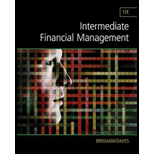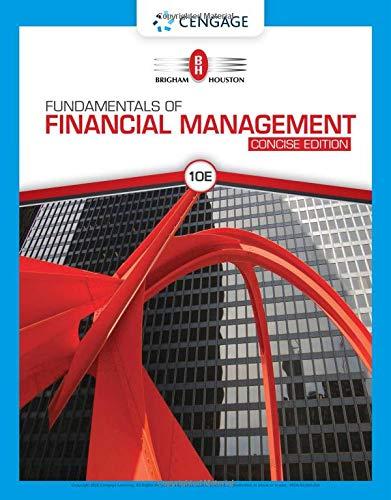
Concept explainers
a)
To determine: Amount of
a)
Explanation of Solution
Given information:
Capital budget is $15,000,000
Net income is $11 million,
DPS dividend per share is $2,
Outstanding shares 1 million,
Capital structure is 30% debt and 70% equity.
Calculation of retained earnings:
Therefore, retained earnings needed is amounted to $10,500,000
b)
To determine: Dividend per share (DPS) and pay-out ratio.
b)
Explanation of Solution
Based on the residual dividend model, the amount $500,000 ($11,000,000-$10,500,000) is available for dividends.
Calculation of dividend per share:
Therefore, dividend per share is $0.50
Calculation of pay-out ratio:
Therefore, pay-out ratio is 4.55%
c)
To determine: Amount of retained earnings needed by company K to fund its capital budget, if it maintains $2 DPS for next year.
c)
Explanation of Solution
Calculation of retained earnings:
Therefore, retained earnings available is amounted to $9,000,000
d)
To determine: Whether company maintains its present capital structure with its DPS and maintain $15 million capital budget without raising new common stock.
d)
Explanation of Solution
Person X views that, company does not maintain because, if it maintains $2 DPS, only $9 million of retained earnings is available for capital projects. Though, if the company is to keep up its present capital structure of $10.5 million of equity is needed. This may necessitate the firm to issue $1.5 million of common stock.
e)
To determine: Portion of current year capital budget could have to be financed by debt.
e)
Explanation of Solution
Retained earnings available is $9,000,000
Calculation of Capital budget financed with Retained earnings:
Therefore, percentage of capital budget financed by retained earnings is 60%
Calculation of Capital budget financed with debt:
Therefore, percentage of capital budget financed by debt is 40%
f)
To determine: External (new) equity needed.
f)
Explanation of Solution
Calculation of retained earnings:
Therefore, retained earnings available is amounted to $9,000,000
Calculation of external equity needed:
Therefore, external (new) equity needed is $1,500,000
g)
To determine: Company’s capital budget for next year.
g)
Explanation of Solution
Calculation of retained earnings:
Therefore, retained earnings available is amounted to $9,000,000
Retained earnings availability is equals the required equity to find new capital budget.
Calculation of capital budget using required equity:
Hence, capital budget is $12,857,143
Therefore, if Company R cuts its capital budget from $15 million to $12.86 million, it will retain its DPS $2.00, its present capital structure and still follow its residual dividend policy.
h)
To determine: Actions taken by company when its
h)
Explanation of Solution
Company can take any one of the following four actions,
- New issue of common stock,
- Cuts its capital budget,
- Company cuts the dividends,
- Change the capital structure by using more debt funds.
Company should recognize that every of these actions is not while not consequences to its cost of capital, stock price or both.
Want to see more full solutions like this?
Chapter 15 Solutions
Intermediate Financial Management (MindTap Course List)
- Can you explain the concept of net present value (NPV) and how it is used in investment decisions?i need answerarrow_forwardCan you explain the concept of net present value (NPV) and how it is used in investment decisions? need explarrow_forwardCan you explain the concept of net present value (NPV) and how it is used in investment decisions?arrow_forward
 Intermediate Financial Management (MindTap Course...FinanceISBN:9781337395083Author:Eugene F. Brigham, Phillip R. DavesPublisher:Cengage Learning
Intermediate Financial Management (MindTap Course...FinanceISBN:9781337395083Author:Eugene F. Brigham, Phillip R. DavesPublisher:Cengage Learning EBK CONTEMPORARY FINANCIAL MANAGEMENTFinanceISBN:9781337514835Author:MOYERPublisher:CENGAGE LEARNING - CONSIGNMENT
EBK CONTEMPORARY FINANCIAL MANAGEMENTFinanceISBN:9781337514835Author:MOYERPublisher:CENGAGE LEARNING - CONSIGNMENT Cornerstones of Financial AccountingAccountingISBN:9781337690881Author:Jay Rich, Jeff JonesPublisher:Cengage Learning
Cornerstones of Financial AccountingAccountingISBN:9781337690881Author:Jay Rich, Jeff JonesPublisher:Cengage Learning Fundamentals Of Financial Management, Concise Edi...FinanceISBN:9781337902571Author:Eugene F. Brigham, Joel F. HoustonPublisher:Cengage Learning
Fundamentals Of Financial Management, Concise Edi...FinanceISBN:9781337902571Author:Eugene F. Brigham, Joel F. HoustonPublisher:Cengage Learning



